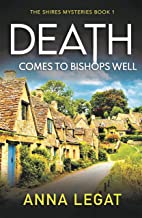During lockdown I had another go at reading Proust, but I’m still struggling. (The good bits are wonderful but the bad bits are like a parody of self-indulgent French intellectualism.) I’ve been given the graphic novel version of volume 1 (yes, it really exists and it’s rather wonderful) and I’m having a go at that. Meanwhile, what I’m actually reading is detective thrillers. Here are the latest (both courtesy of NetGalley)
Death comes to Bishops Well: Anna Legat

Anna Legat is already an established crime thriller writer, but my only experience of her in the past has been through her more ‘experimental’ novels, which have been interesting because of their rather edgy and sometimes nihilistic approach. I’ve seen her writing about adventures in Hell and the end of the world so I was intrigued to see what she would do in the deeply traditional ‘cosy crime’ genre.
Death comes to Bishops Well plays by all the rules. At first I was confused by having a whole heap of individuals thrown at me to sort out into potential victims, possible suspects or would-be detectives, but that more or less goes with the territory. (I enjoy Agatha Christie but I hate the obligatory dinner party at the start with ten guests who we are briefly introduced to and then have to keep track of as we try to work out which one did it.) Legat soon establishes the individual characters who are clearly drawn and interestingly three dimensional. It was the characterisation that kept me going through the initial pages while everyone was assembled together until the big party where one person ends up dead and the others are all suspects.
There’s an interesting narrative twist as chapters alternate between the point of view of a slightly fussy solicitor and his bohemian neighbour who livens up the story by seeing ghosts. The reader needn’t worry, though: the ghosts never speak or interfere with the solution of the mystery which is eventually resolved in traditional Agatha Christie style. They do add an additional layer of fun to a tale that is punctuated by regular stabs of amusement, often at the expense of twee villages like Bishops Well. (It sounds a lovely place to visit but if I had to live there I’d be desperate to be the victim in the next of what promises to be a long series.)
I’m not sure it entirely works as a crime mystery. I can’t say why without major spoilers, but I found the ending unsatisfactory. I’m not sure that Legat’s heart was entirely in finding out whodunnit. She’s much more interested in the people and the fun she can have with their situation – ghosts and all. If you go with the flow (easy enough – she writes well) you’ll have fun too.
A Slow Fire Burning: Paula Hawkins

I ‘read’ this as an audio book. I love crime thrillers on audio (how else would I get the housework done) and this definitely hit the spot.
I wasn’t sure at first. In fact I nearly gave up in the first few minutes as it started with one of those horrific ‘woman about to be raped/murdered’ prologues that linger a little too much on the misogynistic detail. I suspect Paula Hawkins may lose readers with this, which is a shame, because the book isn’t like that at all.
It’s a confusing, messy start, switching from the over-written prologue to a woman bleeding in her bathroom having been injured in some unspecified way. We quickly establish that she is a disturbed young person with unsympathetic parents and then we are away again to another woman and a detailed account of the trials of emptying the chemical toilet on her barge.
By the time we got to the murder I had almost decided not to listen to any more. I’m glad I stuck with it, though. It’s a very good (if deeply depressing) book.
It takes a while to get all the characters sorted out. What links the best-selling author and the miserable middle aged woman on the barge? And how are they linked to the alcoholic who, in turn, links us to the bloodied woman at the start of the book? And what on earth does the prologue have to do with any of it?
It is, as you may imagine, a twisted and tangled tale: twisted in both senses of the word. Almost all the characters are deeply flawed. All have some redeeming feature or, at least, some excuse for being simply awful people, but the truth is that, except for one utterly lovely person, all are very unpleasant – and one, of course, is a murderer.
To tell the truth, I didn’t really care whodunnit. I was carried along wondering how this wretched bunch of people were going to get their lives together or – more realistically – how exactly they were going to crash and burn. It’s not exactly an edifying spectacle but, like any car crash, their stories have an awful fascination.
In the end we do find out who did it. There are twists and turns along the way and the resolution is satisfying, but it’s not really crucial to the enjoyment of the book. It’s just a bloody good read – or, in my case, ‘listen’ – and Rosamund Pike’s narration is spot-on perfect.

Thank you so very much for this wonderful, thoughtful and honest review of my book. Humbled by the company!